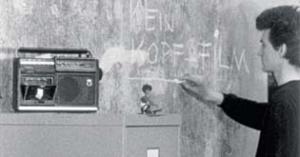In January’s DOUBLE FEATURE British video artist Phil Collins presents “Tomorrow is always too long”, his declaration of love for the city of Glasgow. It will be followed by a screening of “Flug durch die Nacht” by Ilona Baltrusch.
The human mind can be terribly fickle and ungrateful: Always in search of the new and exciting, it forgets at the drop of a hat all those things that only a short while before had precisely these attributes. Be it a lover, one’s social circumstances, a new field of interest or the latest object of desire: much of what held our interest is quickly forgotten. Cities, the social interface between, and the setting for our own private sphere and public life are among the objects consigned to oblivion. The figure of the flâneur, strongly influenced by the French author Charles Baudelaire, still has that fascination and interest in urban space which, in the everyday rush to get from A to B, seems to become totally lost.
A profession of love for Glasgow
We can see “Tomorrow is always too long” (2014), a video work by Turner prize nominee Phil Collins (born 1970), as a kind of manifestation of this fascination. A good 82 minutes long, the film was commissioned by the Glasgow visual arts organization “The Common Guild” and premiered in 2014 in Glasgow as part of the Commonwealth Games cultural program. The film is often described as a profession of love for Glasgow and the work does indeed seem infused with a great deal of affection for the major Scottish city.

“Tomorrow is always too long” is something akin to a filmed collage that seeks to pinpoint the essence of the city. Consisting of documentary-like sections and interviews, the film focuses on various situations in the lives of its citizens: From their birthplace, nursery and school, to prison, and finally to senior citizen’s dances and the inevitable – death. We accompany a couple to antenatal classes and all the way to the delivery room, a juvenile delinquent to jail, and spend a day with the elderly in a dance hall.
A conglomerate of what makes up a city
The individual segments are loosely interspersed with songs by British musician Cate Le Bon, here sung by the protagonists themselves, and short animated films by Matthew Robins. Interviews, advertising clips and outtakes from a quiz show – all of which look like they were made in the overexcited, bubbly 1990s – provide insights into the living realities of the individuals portrayed. “Tomorrow is always too long” is a conglomerate of all that seems to make up a city: institutions, (sub-) culture, education, trash, architecture and, first and foremost, its inhabitants – young and old, smart and dumb, happy and sad.


Collins spent an entire year in Glasgow making the film. Meeting and engaging with the individuals who ultimately feature in his films is crucial to his way of working. “Tomorrow is always too long” is infused with great affection for his protagonists, who operate in front of the camera playfully and in a relaxed manner.
A disco marathon in Ramallah
Collins often works with teenagers in his video works – in “They Shoot Horses” (2004) he documented a disco marathon in Ramallah they had organized themselves, in “The World won’t listen” (2005) he had young people from Turkey, Columbia and Indonesia perform karaoke versions of songs by The Smiths. In works such as “Return of the Real” the artist examined the influence reality TV formats exert on their participants. All of this is echoed in “Tomorrow is always too long”: in the animated films showing a group of teens going overboard at a party and in the exaggerated TV clips that refer to the multimediatization of our everyday life.

In the second part of the evening we will be screening Ilona Baltrusch’s 1980 film “Flug durch die Nacht” (Flight through the Night), which she made while studying at Deutsche Film- und Fernsehakademie in Berlin. Strongly reminiscent style-wise of Jean-Luc Godard’s Nouvelle Vague films, Baltrusch’s film accompanies the two protagonists Gretel Kemeny and Martin Peter through 1980s Berlin at night.
What is cinema? Cinema is eating a bar of chocolate.
The two roam about various places, remaining silent and mysterious except when voicing artificial text fragments such as “What is cinema? Cinema is like eating a bar of chocolate. Just 4 times more expensive” or “death is courting me with such persistence, it really is too much to take” – in an empty club the barkeeper looks straight at the camera and proclaims: “A modern film strip”. Sound engineers or their devices can be seen time and again in the film, and towards the end the director herself can be heard offstage, making it clear that “Flug durch die Nacht” is not really an indie road trip through West Germany.

Ilona Baltrusch, Flug durch die Nacht, Film Still, 1980, via ulrikepfeiffer.com
In Baudelaire’s “Madame Bistouri we read “What odd things are to be found in a large city if you know how to get around and observe! Life abounds with innocent monsters!” If the city is then regarded as a sub-cultural melting pot of diverse intermingling groups, as an abstract construct of codes that are almost impossible to read, as freedom or constriction, inhabited by innocent monsters or guilty angels – it is always more than the sum of its parts and can only ever be experienced or lived according to each particular situation by itself. For example through the eyes of another, as in Phil Collins or Baltrusch’s works, or through one’s own perception: in the classic stroll through urban space.

Ilona Baltrusch, Flug durch die Nacht, Film Still, 1980, via filmportal.de